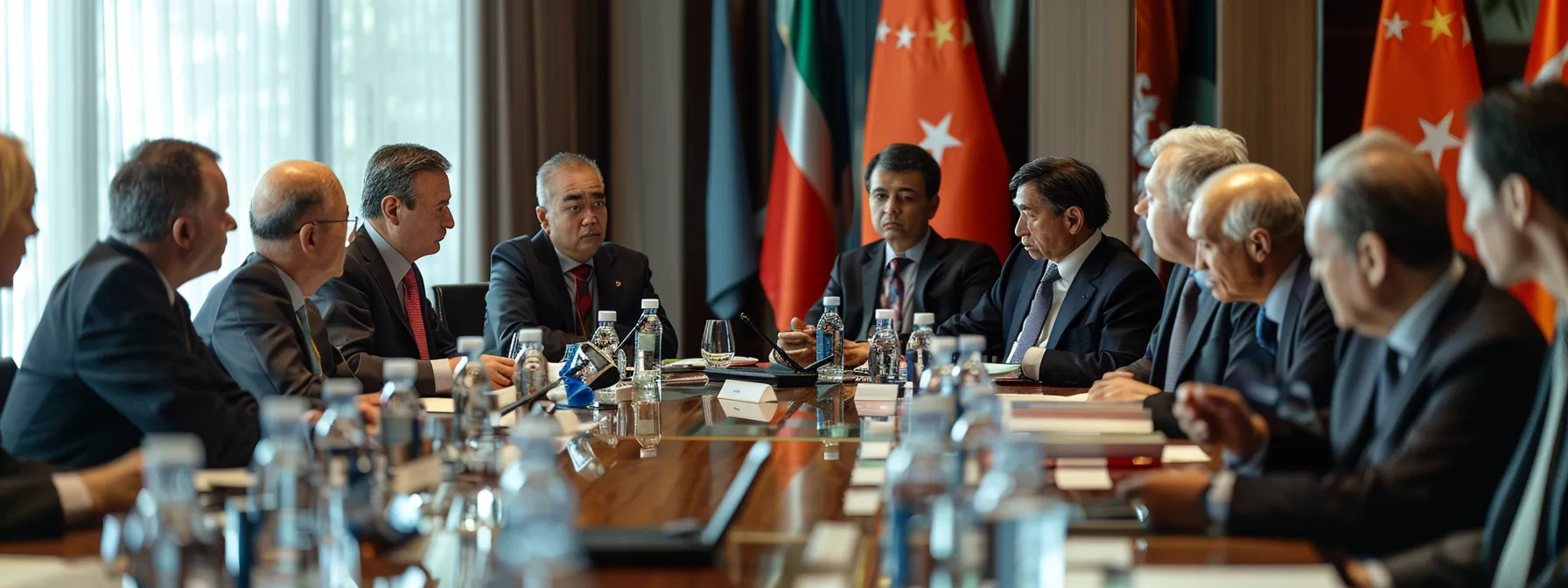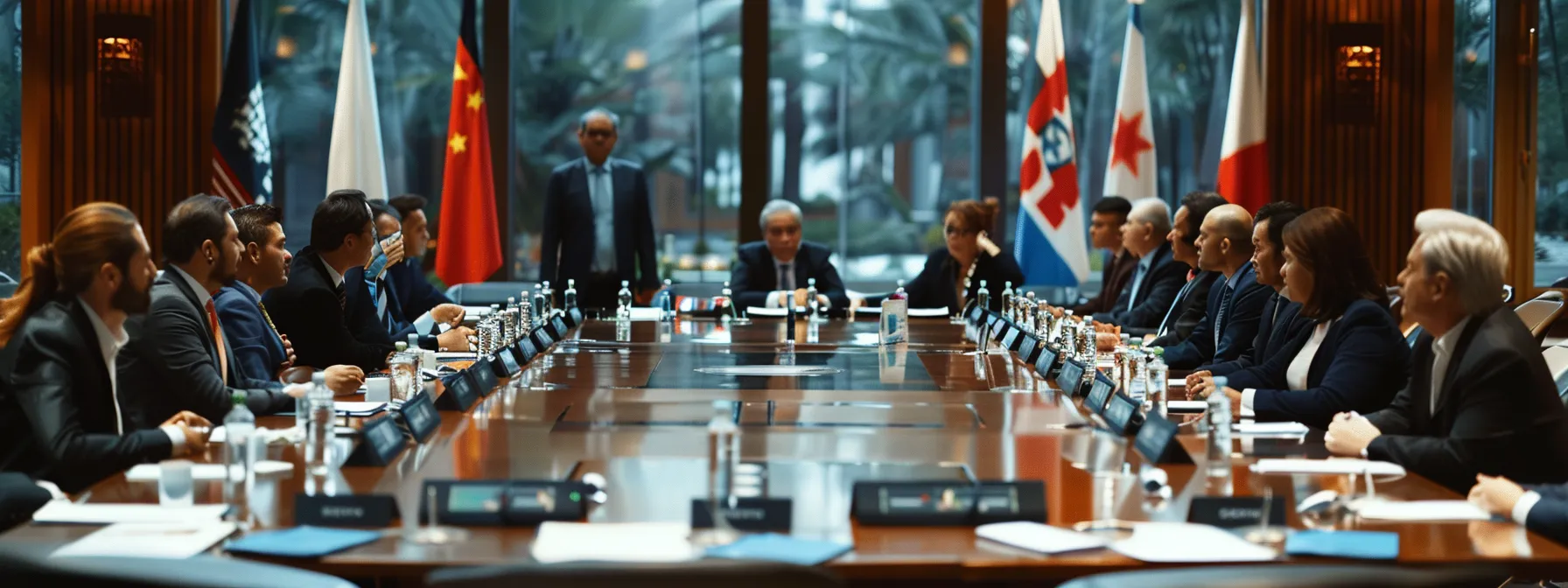Navigating Bilateral and Multilateral Investment TreatiesInvestment Treaties: Analyzing the Key Differences
In the intricate web of global commerce, the stability and predictability of market conditions are elevated through strategic legal frameworks known as investment treaties (“Bilateral vs. Multilateral treaties”). These treaties, crucial in shaping trade relationships, often revolve around the central pillars of enhancing foreign direct investment flows and safeguarding investors‘ rights. They fall predominantly into two categories: bilateral investment treaties (BITs), which are agreements between two nations, and multilateral investment treaties (MITs), which involve multiple parties, such as the comprehensive investment agreements found within the European Union. Investment treaties not only influence economic partnerships but also interface with other significant regimes, including environmental law and the exchange of pivotal information. Keep reading to dissect the nuances and intrinsic details that distinguish Bilateral vs Multilateral Treaties and to understand how they mold the landscape of international investment.
Differences Between Bilateral and Multilateral Treaties Key Takeawa
- Bilateral treaties focus on individual bilateral interests and state sovereignty
- Multilateral treaties balance national agendas with shared international investment frameworks
- Both BITs and MITs establish dispute resolution processes to protect investor-state relations
- Investment treaties directly influence international trade flows and economic growth
- Treaties often integrate cultural and legal nuances specific to the countries involved
Unveiling the Structure of Bilateral Investment Treaties (Bilateral vs. Multilateral treaties)

Bilateral Investment Treaties, commonly abbreviated as BITs, serve as agreements between two countries, seeking to create conducive environments for investors from each respective nation. At their core, BITs consist of meticulously drafted legal provisions aimed not only at promoting economic exchanges but also at providing legal recourse through organizations such as the International Centre for Settlement of Investment Disputes (ICSID). The science of crafting these treaties involves delineating the rights and responsibilities of both the investor and the host nation, thereby fostering trust and predictability in cross-border investments. A thorough review of these documents reveals their scope and limitations, offering a unique intersection between international law and economic strategy. The Netherlands figures prominently in discussions on BITs, showcasing its pursuit of robust economic relationships alongside stringent legal frameworks documented in law reviews and policy analyses.
Defining Bilateral Investment Treaties (BITs)
Bilateral Investment Treaties are international agreements establishing the terms and protections for private investors from one country when investing in another. These treaties, emblematic of bilateralism, often include provisions for fair and equitable treatment, protection from expropriation, and mechanisms for dispute resolution.
The proliferation of BITs, particularly involving powerhouses like China and rapidly developing regions such as Latin America, reflects a commitment to fostering stable investment climates. Awards rendered under these treaties are recognized and enforced globally, underscoring their significance within the framework of the United Nations‘ promotion of international trade and investment.
- International agreements create a protected space for cross-border investments.
- Dispute resolution under BITs garners global recognition and enforcement.
- China and Latin American countries actively engage in bilateral treaties.
Core Components of BITs
The infrastructure of Bilateral Investment Treaties (BITs) is designed to balance the interests of the corporation with those of society, often including measures for environmental protection to ensure that development does not come at the expense of natural resources. BITs may stipulate norms and procedures that safeguard both the environment and the social fabric in which businesses operate, embracing society’s evolving expectations of corporate stewardship.
In regions where principles from Islamic law intersect with contemporary investment frameworks, BITs are carefully tailored to align with both humanethics and financial jurisprudence. Protection clauses within these treaties take into account the specificities of Islamic finance, ensuring that investments are compliant with ethical norms and contribute positively to the economic tapestry of the involved nations.
The Scope and Limitation of BITs
Bilateral Investment Treaties, while aimed at safeguarding investments and fostering mutual economic growth, often face criticism for their limited emphasis on the host country’s sustainable development goals. The scrutiny centers on whether these treaties effectively balance investor rights with the need to promote social and environmental objectives, pivotal for long-term progress.
Germany, an active participant in negotiating BITs, places a strong emphasis on dispute resolution mechanisms. These are critical in ensuring fair treatment and legal certainty for German investors abroad, while also incorporating cultural studies to better understand the host nation’s legal and societal norms.
- BITs are critiqued for inadequately addressing sustainable development goals.
- Dispute resolution mechanisms are vital for German investors operating internationally.
- Cultural studies contribute to the understanding of host country legal systems within BITs.
Exploring the Framework of Multilateral Investment Treaties (Bilateral vs. Multilateral treaties)

Unlike Bilateral Investment Treaties that involve two nations, Multilateral Investment Treaties (MITs) are comprehensive agreements woven together by the will of multiple nations, forming a network of investment procedures and protections. These arrangements, often crafted under the guidelines proposed by the United Nations Commission on International Trade Law, extend beyond the scope of fostering bilateral economic connections to reinforce communal principles among a wider group of states. With an array of key elements such as ‘most favoured nation‘ clauses, MITs dictate equitable treatment among signatories and provide frameworks designed to maintain peace and prevent discrimination. Spain, among others, participates actively in these multilateral agreements, indicating its dedication to promoting uniform investment standards and reinforcing its position within the global economic fabric.
Overview of Multilateral Investment Treaties (MITs)
Multilateral Investment Treaties (MITs) represent complex legal instruments through which nations such as Peru and Uzbekistan agree upon common standards and practices for investment and finance. They emphasize the equitable treatment of rights and outline shared obligations to support international investment in a fair and transparent manner.
At the heart of MITs lies the commitment to unify disparate legal frameworks into a cohesive, international finance strategy. These treaties serve as the pillars supporting a network of cooperative investment opportunities that safeguard equitable rights across multiple jurisdictions.
Key Elements and Provisions in MITs
Within the complex ecosystem of Multilateral Investment Treaties (MITs), a robust database underpins the rapid analysis and comparison of treaty provisions across various jurisdictions. The integration of economics and comparative law within these databases enhances the efficiency of cross-national investment strategies, ensuring legal congruence and economic feasibility.
The English language serves as a principal medium for drafting MITs, which facilitates consistent interpretation and application of treaty provisions. Involvement with international entities such as the International Monetary Fund further ensures that MITs are aligned with macroeconomic stability concerns and global financial policies:
- MIT databases streamline economic and legal analysis for cross-border investments.
- English language usage standardizes treaty understanding.
- International Monetary Fund principles guide MIT economic provisions.
Understanding the Multilateral Framework’s Reach
The inclusivity of the multilateral framework accommodates the diverse perspectives of Christianity, technology, and art, fostering an environment where a rich tapestry of cultural values influences the shaping of international trade policies. In realms such as the United States trade sector, the interplay between ideology, innovation, and creative expression is recognized and integrated within the agreements, shaping economic interactions that are both globally attuned and locally respectful.
Given the multifaceted nature of such treaties, aspects of biology and ecological considerations are embedded within the terms, reflecting an awareness of the symbiotic relationship between economic development and environmental stewardship. This holistic approach not only broadens the framework’s reach but also ensures its relevance in a world where the intersections of scientific understanding and trade are increasingly prominent.
Comparative Analysis of Negotiation Processes

Navigating the intricacies of negotiation dynamics is a cornerstone in shaping Bilateral and Multilateral Investment Treaties. In the case of bilateral agreements, the negotiation process is typically a concentrated dialogue, where individual nations such as Singapore engage directly, allowing for tailored agreements that reflect the unique interests and conditions of the participating entities. The literature on international arbitration illustrates that such focused discussions can lead to more rapid consensus but require astute judgment to align divergent legal systems and economic policies. On the other hand, multilateral treaties introduce complex interplays among multiple nations, demanding a broader consensus that challenges negotiators to reconcile a wider array of interests and strategic priorities. The robust decision-making involved in these negotiations directly influences the protective measures for investors, the reach of insurance clauses, and the robustness of dispute resolution mechanisms within the treaties. Ultimately, the nature of these negotiations, whether bilateral or multilateral, profoundly impacts the architecture and efficacy of the resulting agreements, setting the stage for global investment and the advancement of international arbitration protocols.
Bilateral Treaties: A Closer Look at Negotiation Dynamics
The negotiation dynamic of bilateral treaties often unfolds in an environment where two sovereign states focus on aligning their interests and legal frameworks. Careful attention is given to the impact that corporate social responsibility mandates might have on domestic policies and international relations, with evidence from prior negotiations informing current tactics.
In bilateral treaty discussions, it’s not uncommon for issues of religion to surface, influencing the terms of engagement between the nations involved. This is particularly visible through available website resources that document past treaty negotiations, showcasing how cultural nuances shape the dialogue between countries.
Multilateral Treaties: Negotiating With Multiple Parties
Negotiating multilateral treaties requires a delicate balance between national self-interest and the broader principles of multilateralism. Each participating party must not only press the button on their agenda but also navigate through a complex web of regulations that underpin international trade and investment. The intricate process demands a seamless integration of diverse perspectives, with an incentive for mutual gain driving negotiations forward.
The creation of a multilateral treaty often culminates in a comprehensive pdf document that encapsulates the agreed-upon terms. This document serves as the definitive reference for international law practitioners, investors, and policy-makers, outlining the consensus reached after a rigorous negotiation marathon. It stands as a testament to the power of collective action in a globalized economy.
- Negotiators balance national interests with the principles of multilateralism.
- The treaty‘s pdf document becomes a key resource in international investment.
The Impact of Negotiation Processes on Treaty Outcomes
The culmination of a negotiation process for every trade agreement influences the operational dynamics between the investing entities and the host nation. Whether through bilateral or multilateral channels, the intricate conversation charts the course of business interactions and dictates the framework within international trade law.
Accurate knowledge representation is a significant outcome of these negotiation processes, as it forms a bedrock for stakeholders to adhere to guidelines framed by the World Trade Organization or the OECD. An effective negotiation strategy leaves an indelible mark on the treaty, ultimately sculpting its capacity to facilitate fair and fruitful trade relations.
- Negotiations set the stage for defining business operations and international trade law interactions.
- The reflection of knowledge in negotiated trade agreements aligns with WTO and OECD frameworks.
Dispute Settlement Mechanisms: BITs vs MITs

Both Bilateral Investment Treaties (BITs) and Multilateral Investment Treaties (MITs) encompass provisions for resolving disputes that emerge between investors and states, yet they differ fundamentally in their approach to upholding contractual obligations and applying customary law. Within the remit of BITs, international organizations frequently mediate to resolve conflicts pertaining to propertyrights and breaches of contract, offering investors a sense of security in their international ventures. In contrast, the dispute resolution process under MITs—which often forms part of a broader free trade agreement—aims to deliver a unified mechanism that caters to multiple parties, thereby promoting efficiency. An in-depth examination of these mechanisms reveals significant insights into their effectiveness in addressing cross-border investment concerns and fostering a stable environment for commerce and development.
Resolving Investment Disputes in BITs
In resolving investment disputes that arise under Bilateral Investment Treaties, the invocation of precedent plays a pivotal role. Lawyers expertly navigate the complexities of previous rulings to ensure the rule of law is upheld, drawing on comprehensive legal texts such as those published by Oxford University Press.
Adherence to established policy within international arbitration under BITs is integral to maintaining consistency and fairness in dispute resolution. This reliance on structured legal frameworks provides investors with a sense of reliability, knowing their cases will be adjudicated with respect to historical legal doctrine.
The Dispute Resolution Process in MITs
The management of disputes under Multilateral Investment Treaties involves a collaborative approach, necessitating fluency not just in legal discourse but also in multilateral diplomacy and the languages spoken by the involved parties. The varied nature of these treaties demands a comprehensive grasp of the multiple legal systems intertwined with the principles of international trade law.
Resolving tensions within the context of MITs often requires an understanding of the cultural and legal subtleties that are unique to Latin American jurisprudence. As participants converge to address investment conflicts, the shared language of the treaties provides a common ground for interpretation, ensuring that the resolutions are consistent with the spirit and letter of international trade law.
Efficiency and Effectiveness of Various Mechanisms
When assessing the efficiency and effectiveness of dispute settlement mechanisms present in Bilateral and Multilateral Investment Treaties, one observes keenly how they are informed by the layered heritage of archaeology. Just as archaeologists decipher humanhistory to understand societal evolution, legal experts in international investment agreements dissect past cases to refine current adjudication methods. These refined methods streamline conflict resolution, ensuring expedient and equitable outcomes for international investors.
The study of international economics incorporates both numerical and qualitative analyses to uncover patterns and trends within global markets. In the context of international investment agreements, such as those involving Argentina, the nation’s advancements in education have informed its approach to structuring and negotiating effective dispute resolution policies. Through informed mechanisms, Argentina ensures its treaties provide solid frameworks for protecting investments while fostering sustainable economic growth.
- Archaeological methodologies inspire legal analysis in international investment agreements.
- Argentina integrates international economics and educational excellence in dispute resolution.
The Role of State Sovereignty in Investment Treaties (Bilateral vs. Multilateral treaties)

State sovereignty remains a pivotal concept as nations navigate the complexities of international investment treaties. In Bilateral Investment Treaties (BITs), individual states exert significant control over market access and the conditions under which investments may proceed, setting firm boundaries within which foreign entities can operate. These BITs often involve a detailed mapping project to align a country’s legislation with treaty obligations, preserving the delicate balance between welcoming foreign investment and maintaining legislative autonomy. Conversely, the Multilateral Investment Treaties (MITs) present a different dynamic, as the Office of the United States Trade Representative and similar entities work to harmonize broader policies that can impact multiple jurisdictions concurrently. Turkey, among others, exemplifies how states negotiate their role in such agreements, endeavoring to protect their sovereign rights while accommodating the interests of a collective international community. In both BITs and MITs, the challenge involves a negotiation dance that seeks to fortify investor confidence without undermining the host nation’s authority and regulatory prerogatives.
State Sovereignty in the Context of BITs
State sovereignty in the context of Bilateral Investment Treaties (BITs) plays a decisive role in managing the flow of capital and maintaining a balance with customary international law. Slovakia, for example, has leveraged its BITs to attract foreign capital while ensuring that the terms align with its national interests and legal standards.
Australia‘s approach to BITs reflects a keen understanding of the delicate interplay between state sovereignty and bilateral trade. The country carefully structures these agreements to preserve its legislative autonomy while creating a welcoming environment for international investments.
How MITs Approach State Sovereignty
In the realm of Multilateral Investment Treaties, the Middle East demonstrates a nuanced approach to state sovereignty, reconciling the need for open access to investment opportunities with the prerogatives of national security and regulation. These treaties are carefully constructed to reflect the mosaic of sources of law within the region, ensuring that the collective security concerns and humanrights standards of the signatory countries are adequately addressed and respected.
MITs uniquely navigate the delicate equilibrium between empowering the flow of international investments and upholding the sovereign rights of individual states, with particular regard for their self-defined legal and ethical frameworks. In doing so, multilateral agreements offer a platform where the Middle East can engage globally while ensuring its legal traditions and commitments to humanrights remain integral to the investment landscape.
Balancing Investor Rights With State Sovereignty in Bilateral vs. Multilateral Treaties
To ensure a harmonious equilibrium between the rights of investors and nation-state autonomy, South Korea carefully tailors each international investment agreement. The nation’s strategy illustrates a vigilant preservation of sovereign interests while permitting foreign capital to spur domestic growth.
In the context of the North American Free Trade Agreement, librarian levels of detail are applied to safeguard the harmonization of investor provisions with state regulations. Each clause is scrutinized to maintain the delicate balance that respects the sovereignty of the parties involved while protecting investor rights.
Assessing the Impact of Investment Treaties on Global Trade (Bilateral vs. Multilateral treaties)

The landscape of international commerce is intrinsically shaped by the frameworks of investment treaties, with bilateral and multilateral agreements paving distinct pathways for economic growth. Researchers endeavor to quantify the specific effects of Bilateral Investment Treaties on trade flows, dissecting the intricate ways in which these agreements incentivize or deter cross-border investments. Among the most scrutinized is the influence of the Transatlantic Trade and Investment Partnership, a beacon that demonstrates the potential for regional economic integration. In parallel, the architecture of Multilateral Investment Treaties casts a wider net, embedding itself into the intricate fabric of global trade and providing a more unified approach to investment practices. At the crux of their effectiveness lies the arbitration process, an adjudicative tool with a deep history that continues to define the nuances of investor-state disputes. Evaluating these treaties in their totality reveals a complex but coherent image of their place within the global market, necessitating a blend of economic acumen and legal precision to decipher their ultimate impact on international trade dynamics.
Influence of Bilateral Treaties on Trade Flows
Entities such as financial institutions play a pivotal role in mediating the effects of Bilateral Investment Treaties on trade flows, especially in cases where a developed country engages with emerging markets like Colombia. The exchange of capital, bolstered by the stability afforded by these treaties, can lead to significant increases in trade volumes between the signatory states.
Moreover, stipulations within Bilateral Investment Treaties often confront pressing global issues, including those related to climate change, which can influence the direction and volume of trade. For example, treaty provisions may incentivize green technology investments with favorable tax conditions, thus impacting trade flows by encouraging environmentally sustainable practices in international commerce.
The Role of Multilateral Treaties in Shaping Global Trade
Multilateral treaties, including those fostering free trade, have significant implications for global commerce, often mandating equitable practices that reduce discrimination. For instance, Bolivia‘s active participation in multilateral agreements underpins its trade policies, promoting sustainable economic relations that adhere to global standards such as those set by the United Nations Framework Convention on Climate Change.
Moreover, these expansive agreements function as an international password, unlocking trade barriers and establishing a unified approach to economic exchange and environmental stewardship. This cohesive framework stimulates trade while ensuring that member nations abide by principles that actively combat discrimination and promote responsible environmental management as outlined in international accords.
Evaluating the Overall Effectiveness of Investment Treaties
El Salvador‘s engagement with investment treaties exemplifies the nuanced influence such agreements can have based on geography and policy landscape. As a primary source of legal stability for foreign investors, these treaties enable countries like El Salvador to delineate their investment menus, showcasing diverse options that align with their developmental stage and topographical potential.
The signature of investment treaties often embarks nations on a transformative journey, where economic outcomes hinge on compatibility with domestic interests. Scholars evaluate these documents’ role from a global perspective, tracing the trajectory of trade benefits and economic shifts attributable to treaty stipulations and their adherence.
Conclusion (Bilateral vs. Multilateral treaties)
Bilateral Investment Treaties (BITs) allow two countries to tailor agreements to their specific legal and economic landscapes, offering investors clear-cut protections and rights. Multilateral Investment Treaties (MITs), on the other hand, demand consensus among numerous nations, aiming to establish standardized protocols for investment that transcend individual borders. BITs can directly influence trade flow between the signatory countries, while MITs unify a broader range of international practices, facilitating global trade on a larger scale. The choice between bilateral and multilateral agreements reflects a nation’s strategic approach to foreign investment, balancing national interests with the complexities of the international market. Our office guides foreign investors in mitigating their investment risks. Contact us Today!


